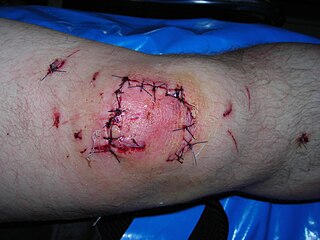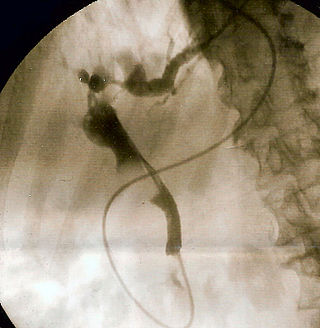Negligence is a failure to exercise appropriate and/or ethical ruled care expected to be exercised amongst specified circumstances. The area of tort law known as negligence involves harm caused by failing to act as a form of carelessness possibly with extenuating circumstances. The core concept of negligence is that people should exercise reasonable care in their actions, by taking account of the potential harm that they might foreseeably cause to other people or property.
In Western jurisprudence, concurrence is the apparent need to prove the simultaneous occurrence of both actus reus and mens rea, to constitute a crime; except in crimes of strict liability. In theory, if the actus reus does not hold concurrence in point of time with the mens rea then no crime has been committed.
Grievous bodily harm is a term used in English criminal law to describe the severest forms of battery. It refers to two offences that are created by sections 18 and 20 of the Offences against the Person Act 1861. The distinction between these two sections is the requirement of specific intent for section 18; the offence under section 18 is variously referred to as "wounding with intent" or "causing grievous bodily harm with intent", whereas the offence under section 20 is variously referred to as "unlawful wounding", "malicious wounding" or "inflicting grievous bodily harm".

Bolam v Friern Hospital Management Committee [1957] 1 WLR 582 is an English tort law case that lays down the typical rule for assessing the appropriate standard of reasonable care in negligence cases involving skilled professionals such as doctors. This rule is known as the Bolam test, and states that if a doctor reaches the standard of a responsible body of medical opinion, they are not negligent. Bolam was rejected in the 2015 Supreme Court decision of Montgomery v Lanarkshire Health Board in matters of informed consent.

R v Brown[1993] UKHL 19, [1994] 1 AC 212 is a House of Lords judgment which re-affirmed the conviction of five men for their involvement in consensual unusually severe sadomasochistic sexual acts over a 10-year period. They were convicted of a count of unlawful and malicious wounding and a count of assault occasioning actual bodily harm. The key issue facing the Court was whether consent was a valid defence to assault in these circumstances, to which the Court answered in the negative. The acts involved included the nailing of a part of the body to a board, but not so as to necessitate, strictly, medical treatment.
Causation is the "causal relationship between the defendant's conduct and end result". In other words, causation provides a means of connecting conduct with a resulting effect, typically an injury. In criminal law, it is defined as the actus reus from which the specific injury or other effect arose and is combined with mens rea to comprise the elements of guilt. Causation only applies where a result has been achieved and therefore is immaterial with regard to inchoate offenses.

Reibl v Hughes [1980] 2 S.C.R. 880 is a leading decision of the Supreme Court of Canada on negligence, medical malpractice, informed consent, the duty to warn, and causation.
Murder is an offence under the common law of England and Wales. It is considered the most serious form of homicide, in which one person kills another with the intention to cause either death or serious injury unlawfully. The element of intentionality was originally termed malice aforethought, although it required neither malice nor premeditation. Baker, chapter 14 states that many killings done with a high degree of subjective recklessness were treated as murder from the 12th century right through until the 1974 decision in DPP v Hyam.
Causation in English law concerns the legal tests of remoteness, causation and foreseeability in the tort of negligence. It is also relevant for English criminal law and English contract law.
R v Blaue (1975) 61 Cr App R 271 is an English criminal law appeal in which the Court of Appeal decided, being a court of binding precedent thus established, that the refusal of a Jehovah's Witness to accept a blood transfusion after being stabbed did not constitute an intervening act for the purposes of legal causation. This upheld the decision of Mocatta J. in the court below.

R v Dear [1996] is an English criminal law case, dealing with homicide and causation. The court ruled, slightly extending R v Holland, that even if a victim aggravates his wounds sufficiently to cause otherwise avoidable death, the chain of causation is not broken.

R v Cheshire [1991] 1 WLR 844 is an English criminal law case establishing the role of the jury in finding liability for death, where subsequent medical negligence occurs following the original injury. The Court of Appeal found that the jury did not have to weigh up different causes of death, and need only be satisfied that the defendant's actions made a "significant contribution" to the victim's death.

Fairchild v Glenhaven Funeral Services Ltd [2002] UKHL 22 is a leading case on causation in English tort law. It concerned malignant mesothelioma, a deadly disease caused by breathing asbestos fibres. The House of Lords approved the test of "materially increasing risk" of harm, as a deviation in some circumstances from the ordinary "balance of probabilities" test under the "but for" standard.

Bailey v Ministry of Defence [2008] EWCA Civ 883 is an English tort law case. It concerns the problematic question of factual causation, and the interplay of the "but for" test and its relaxation through a "material contribution" test.

Gregg v Scott [2005] UKHL 2 is an English tort law case, on the issue of loss of a chance, in causation. It affirms the principle of Hotson v East Berkshire Area Health Authority, on a narrow margin of 3 to 2. Lord Nicholls' dissent is of particular note, in arguing that loss of a chance should be actionable.

R v Jordan (1956) 40 Cr App R 152 was an English criminal law case that has been distinguished by two later key cases of equal precedent rank for its ruling that some situations of medical negligence following a wounding are those of breaking the chain of causation, capable of absolving a person who has inflicted bodily harm of guilt for an offence of the severity resulting from a consequent decline in bodily condition, in particular, homicide. The facts were ones whereby a wound was should to be almost certain, with no treatment, to heal itself. The medical attempt to facilitate recovery from the wound resulted in a non-prosecutable death as it was shown to have been negligent and principally an antibiotic error though far from unknown and well-intentioned. The appropriate charge(s) would be ones relating to wounding or disorder of the defendant, rather than homicide which could not have been said to have been caused by the defendant in any meaningful way.
Prisoner suicide is suicide by an inmate in a jail or prison.

The eggshell rule is a well-established legal doctrine in common law, used in some tort law systems, with a similar doctrine applicable to criminal law. The rule states that, in a tort case, the unexpected frailty of the injured person is not a valid defense to the seriousness of any injury caused to them.
South African criminal law is the body of national law relating to crime in South Africa. In the definition of Van der Walt et al., a crime is "conduct which common or statute law prohibits and expressly or impliedly subjects to punishment remissible by the state alone and which the offender cannot avoid by his own act once he has been convicted." Crime involves the infliction of harm against society. The function or object of criminal law is to provide a social mechanism with which to coerce members of society to abstain from conduct that is harmful to the interests of society.
In S v Tembani, an important case in South African criminal law, especially in respect of the issue of legal causation, it seemed to the Witwatersrand Local Division, following the approach of English law, to be "of overriding importance that the original wound inflicted by the accused was an operating and substantial cause of the death of the deceased." If, at the time of death, the original wound is still an operating and substantial cause of death, then the death is a result of the wound, even if another cause was also operating. The court thus appeared to endorse the "proximate-cause" criterion, also known as direct-consequences or individualisation theory, of legal causation. The court added that death is not the result of the original wound if it is just the setting in which another cause operates. Only if the second cause is so overwhelming as to make the original wound merely part of the history may it be said that death does not flow from the wound.









